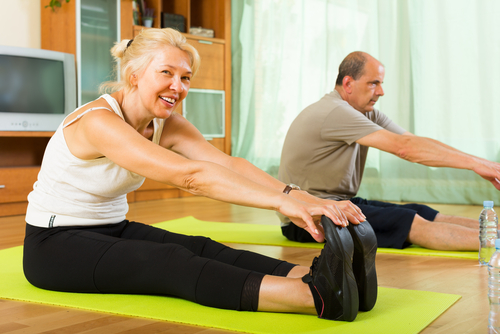Joints. We don’t think a lot about them until they start to hurt and get stiff, but our joints are so incredibly important to our overall health and quality of life. Our joints form the connections between our bones while offering structural support and ease of movement. It goes without saying that any damage to our joints from disease or injury can cause us significant pain and interfere with our mobility.
As we mentioned in an earlier blog post, there are many different reasons you may start to experience stiffness and joint pain. Let’s recap some of the most common causes of these symptoms:
Rheumatoid Arthritis (RA) – A chronic auto-immune inflammatory disorder that generally affects the lining of the small joints in your hands and feet. Although rheumatoid arthritis can occur at any age, it usually begins after age 40.
Osteoarthritis – Although osteoarthritis is often confused with RA, and they both share similar symptoms, osteoarthritis is actually caused by common wear and tear to the joints over time or by an injury. Both of these causes result in degeneration to the hard, smooth layer of cartilage that protects the ends of our bones and mild to significant pain.
Lupus – Unlike osteoarthritis and RA that present themselves to people over the age of 40, lupus typically presents in young women, although it isn’t exclusive to them. This disease not only causes bone and joint pain but also facial rashes, hair loss and seizures.
Infections – Our joints can become infected when bacteria or viruses infiltrate into the space. When this occurs, there is a local immune response that brings about swelling and pain.
Gout – When the uric acid crystals that form with gout get into the joint, patients can experience acute pain and swelling.
Fibromyalgia – This disease causes joint pain as well, though the pain is actually located in the soft tissues. The disease is yet to be fully understood but so far medical expert believe with this condition, the body’s perception of normal stimuli is altered so that widespread pain occurs, frequently in the joints.
As we discussed in our last blog post, there are many foods that we can turn to to combat not only the symptoms of joint pain, but also to get to the root of the problem. Foods like extra virgin olive oil, bell peppers, eggs and apples are all packed full of beneficial nutrients that decrease inflammation, ease joint pain and increase mobility.
Besides proper nutrition, there are other things that joint pain sufferers can do to alleviate their symptoms and promote joint health.
Lose Weight
There are myriad benefits to losing excess weight, but one of the biggest is lessening the stress we put on our joints when we carry all of that excess weight around. Losing even a small amount like 10 pounds will improve joint health, lessen pain, and decrease your risk of developing osteoarthritis.
Support Strong Bones with Calcium
You’ll want to make sure you are eating plenty of calcium rich foods to keep your bones strong and lower your risk of osteoporosis (brittle bone disease). If you aren’t a fan of milk, there are plenty of other sources of calcium like yogurt, broccoli, salmon, figs and kale. There are also a number of quality calcium supplements on the market.
Warm Up Your Body BEFORE Exercise
Although moderate exercise is essential in keeping your joints flexible and healthy, you should always warm up your body before hitting the gym. For optimal joint safety make sure to start slow and increase your speed and/or weight only after your muscles and joints have had at least five minutes to warm up.
Stretch
Many medical experts believe stretching is one of the most important exercises anyone can do, especially for those who suffer from different forms of arthritis. It is ideal if you can stretch daily, but be sure to stretch at least three times a week so your muscles stay flexible and won’t pull your joints out of alignment. But, as with any exercise, never stretch cold muscles, always warm them up first.
Try Yoga
And speaking of stretching…
It would seem that yoga is a hot new trend, but the practice has actually been around for 5,000 years. Yoga is an amazing exercise that not only strengthens your muscles and keeps them long and flexible, it also helps to calm your mind and energy. That is a definite win/win.
Take a Load Off
No, not another reminder about losing weight. If you are already experiencing some joint pain and stiffness, it’s a good idea to wear elbow, wrist and other joint braces to prevent injury and reduce the load on your joints. You may find that these braces even improve your game!
Get a Rub Down
If you’re one of those people who has trouble justifying money for getting pampered from a massage, consider it part of your health maintenance. Massage relieves muscle tension which can cause your joints to be pulled out of alignment. Certain forms of massage like Swedish massage, focus not only on your muscles but on your joints as well to lessen pain and improve mobility.
Strengthen Your Core
Every part of your body is completely linked with every other part of your body. When you have weak ab and back muscles, you can have trouble balancing. But when you strengthen your entire core you can balance much better. The more balanced you are, the less damage that will befall your joints.
Focus on a Full Range of Motion
Not every exercise will take your joints through a full range of motion so it’s important to focus on the ones that do to reduce stiffness and keep joints flexible. If you have arthritis, speak to your doctor or physical therapist and have them recommend daily range-of-motion exercises.
Don’t Overdo It
At any age it’s normal to have some soreness after any exercise, but pay attention – should the pain last longer than 48 hours, you may have overstressed your joints. It’s important to know your joints’ limits and not overexert yourself. Don’t listen to the common belief of ‘no pain, no gain.’ When it comes to the health of your joints, working through pain may lead to injury.
 Validating...
Validating... 






Leave a Reply